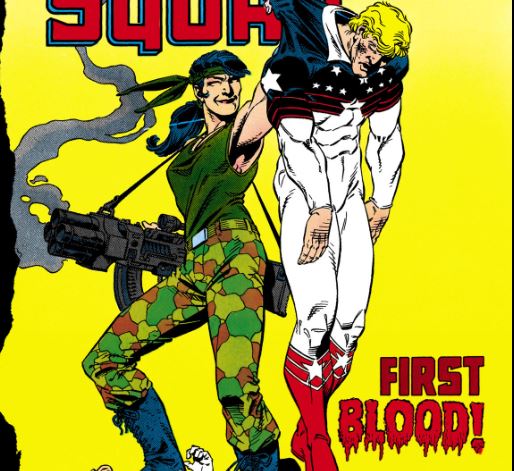
Welcome to another Suicide Squad retrospective where I give my thoughts on each issue of the classic 1987 series. And if you thought we were done with tie-ins and crossovers galore, think again. This time, the Squad gets mixed up in The Janus Directive, a conspiracy that spans multiple series including Checkmate (1987), Manhunter (1988), Firestorm: The Nuclear Man (1987), and Captain Atom (1986). So without further ado, let’s buckle down and jump right in. And, as always, here are links to previous entries.
Suicide Squad #26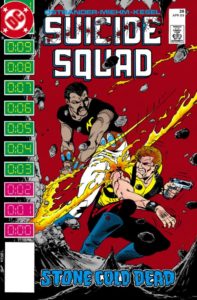
This issue begins with a tour of Jotunheim, an impenetrable fortress that once served the Nazis during World War II. Currently, it is the home of The Jihad, who are still active after losing to the Squad in Issue #18.
The Jihad’s last appearance gave way to the similarities between them and the Suicide Squad. This idea is continued here with a parallel narrative between Jotunheim and Belle Reve. When Rustam explains his preference to develop the team’s own metahumans, I could not help but think of Waller. Manipulation and control is her bread and butter, after all, and what better way than to create your own soldiers? The tour inside Jotunheim reads almost like a warning for what Amanda Waller could become: Her own worst enemy.
However, this quickly becomes Rick Flag’s story. M.I.A after making questionable decisions in Suicide Squad #21, Flag decides to make … more questionable decisions. This time, he is going to singlehandedly blow up Jotunheim with an atom bomb buried beneath the fortress by his father and the original Suicide Squad. Again, questionable decisions.
Born into a military family, Flag is all too familiar with sacrifice. His philosophy to “carry on” stems from the fact that people much better than him have sacrificed their lives, and he must honor that. But in his letter to Eve, it is clear that he has had it with a country that continually takes but gives nothing back. He does not ask Eve to carry on for him, because he does not want to burden her with duty. Instead, he advises her to leave the Squad and live a full life, right before the bomb claims his own. It’s an incredibly well-paced ending that creates genuine shock over the finality of it. Is this the true ending of Rick Flag?
The Janus Directive, Part 1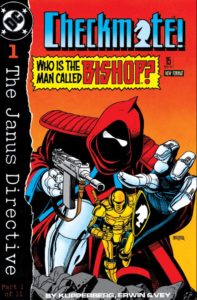
Checkmate #15 largely stands on its own up until its final page. However, Squad readers will be familiar with writer Paul Kupperberg, who scripted The Doom Patrol/Suicide Squad Special #1 (1988). Valentina Vostok, a.k.a. Negative Woman from the Doom Patrol, is a familiar face for Squad readers as well. But aside from that, we’re left to our own devices as to what, exactly, Checkmate is. Based on references in past Squad issues, Checkmate seems like another clandestine government organization not unlike the Suicide Squad. But despite the initial confusion, this issue is still mostly entertaining.
A lot is packed into this issue, but the main showdown is between Knight and Bishop. They both have chess-themed names so it was a little confusing at first why they were fighting, but it is an entertaining matchup nonetheless. Bishop’s hulking, tank-like armor is daunting, the perfect counter to Knight’s sleek, shiny, and mobile suit. But the fight proved mostly meaningless after Waller appears to announce the start of The Janus Directive. We also get our first reference to “Project: Peacemaker,” the character John Cena will be playing in James Gunn’s The Suicide Squad (2021).
The Janus Directive, Part 2-4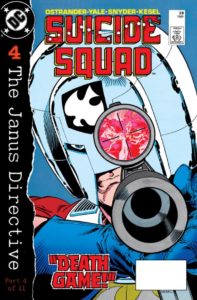
There are lots of moving pieces here, and it is still unclear what exactly The Janus Directive is. Simply put, there is a conspiracy to pit each major intelligence agency against one another. This includes Task Force X, Checkmate, Force of July (A-plus name, by the way), and The Atom Project. But who is behind it all is the mystery that drives the narrative between Suicide Squad #27, Checkmate #16, and Suicide Squad #28, respectively. This information also comes from Waller, so of course everyone is skeptical and none more so than Bronze Tiger. He’s seen firsthand the consequences of relying on faulty information, and he confronts Waller about it. And, though she has previously expressed remorse over sending the Squad on faulty missions, Waller is decidedly dismissive of his concerns. Or anyone else’s concern for that matter.
The Suicide Squad has been aptly labeled as DC’s Island of Misfit Toys. Certainly, one of the more entertaining aspects is watching the various supervillains operate. Count Vertigo has become a staple Green Arrow villain, so it is neat to see the character flash potential here with his headache-inducing powers. But I ended up loving Dr. Light’s moment the most. Not because he has cool powers, mind you, but because the poor guy spends most of Suicide Squad #27 absolutely terrified of a child. But the second you start wondering how Dr. Light is a threat, he goes on to murder said child. Then he celebrates like it’s a major life accomplishment. It is a dark reminder that as silly as these characters are, they are still unhinged individuals capable of great harm.

According to the promotional material, it looks like DC is gearing up for John Cena’s Peacemaker to make a big splash. The character is not only being played by a well-liked actor, but there is a television miniseries lined up as well. Cena describes Peacemaker as a “douchey Captain America” and honestly, the comparison isn’t that far off. He’s just a guy that cares about peace, no matter the cost. That last bit is simply ripe for James Gunn’s brand of humor.
The Janus Directive, Part 5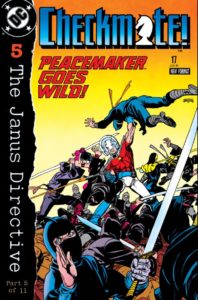
While the last issue revealed Kobra as the mastermind, Checkmate #17 introduces another significant development. Skeptical of Waller’s motives, General Eiling and Harry Stein form an uneasy alliance between the Atom Project and Checkmate. No one knows Kobra is behind everything yet, so all signs point to Waller playing her usual mind game with everyone. There is even talk of doppelgangers infiltrating the intelligence community, something that was hinted at in Suicide Squad #25. So far, though, I have been mostly enjoying the espionage aspect of this crossover. It is interesting to see the intelligence community, who all thrive on being prepared for anything, let their paranoia destroy each other.
The Janus Directive, Part 6-9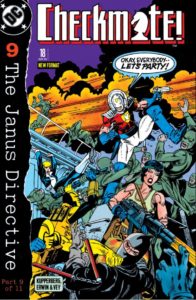
So far, The Janus Directive has moved at a relatively brisk pace despite the many moving pieces. However, these next four issues, across Manhunter, Firestorm, Suicide Squad, and Checkmate, bring the crossover to a grinding halt. This is partly because there is a lot of set up, but there are also too many characters. For example, Firestorm looks like he is simply going to be the crossover’s deus ex machina. He does not have a good reason for being included. In fact, Firestorm has a much more interesting air pollution plot that gets overshadowed. Likewise, Manhunter balances the crossover well with itself. It helps that he is a street-level vigilante as opposed to a god-like being like Firestorm, but the issue also does a great job of establishing who Mark Shaw is outside of his Squad appearances.
 Suicide Squad and Checkmate also have too much going on for their own good. There are a couple bombastically standard superhero crossover battles, but there is not enough time for characters to shine. Peacemaker, on the other hand, does have some fun, dense-headed moments. And if you are one of those people who does not understand what “yeeting” is, just know that Peacemaker is basically the physical embodiment of that phrase. It is practically his superpower.
Suicide Squad and Checkmate also have too much going on for their own good. There are a couple bombastically standard superhero crossover battles, but there is not enough time for characters to shine. Peacemaker, on the other hand, does have some fun, dense-headed moments. And if you are one of those people who does not understand what “yeeting” is, just know that Peacemaker is basically the physical embodiment of that phrase. It is practically his superpower.
Then there is Kobra’s evil plan, which is completely outrageous. But I love it simply for the sheer audacity of it. They have a giant space gun. Said space gun will fry the brains of everyone on Earth. Afterwards, Kobra will repopulate the planet in their own image and bring about the Kali Yuga, an Age of Chaos. Again, stupid evil genius plan whose simplicity works in the face of the complicated inter-departmental rivalry from past issues.
The Janus Directive, Part 10
Suicide Squad #30 gathers the entirety of America’s disparate intelligence agencies into one, full-blown assault on Kobra’s space headquarters. It is the massive superhero brawl that is required for every superhero crossover. But unlike the past two issues, there is room for just about everyone to shine. This includes Naga-Naga’s hilariously casual stroll across the backs of his willing followers. Everything about Kobra screams camp—they wear snake costumes, Naga-Naga speaks in hissing noises, and his name is Naga-Naga—but it works surprisingly well.
Suicide Squad Annual #1 establishes Kobra as cowards who pose no physical threats. Instead, having Kobra sow paranoia is a great way to establish why they should be taken seriously. Or maybe it’s more indicative of why everyone else needs to get their act together. I mean seriously, the entire U.S. intelligence community nearly got duped by the reptilian equivalent of a furry cult for Pete’s sake.
One disappointing aspect that I wish was explored more was Ravan’s ties to Kali Yuga, the Age of Chaos. While Kobra welcomes the Kali Yuga, Ravan believes in preventing it through sacrifice, a.k.a murder. Each kill he makes delays the Age of Chaos for another thousand years, which is something we learned in past issues. This dichotomy could have been an interesting facet of the DC Universe to explore, but instead, it is sadly ignored. I do, however, enjoy how Ravan’s schtick is to violently strangle people with a string. It’s befitting of his cruel nature despite how outlandish it looks in the middle of a superhero battle.
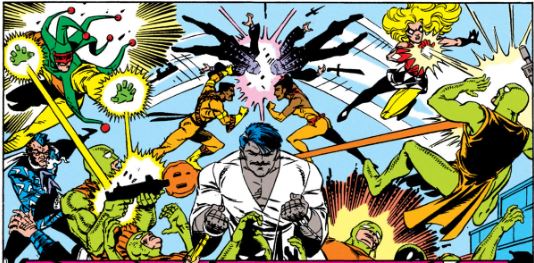
By the end though, the consequences following The Janus Directive do not seem all that consequential. The President reorganizes the different agencies and everyone now reports to Sargent Steel. Amanda Waller also gets a stern warning from The President to play by the rules from now on. That is all, and unfortunately, it does not feel worth the price of interrupting the regular Squad series.
The Janus Directive, Part 11
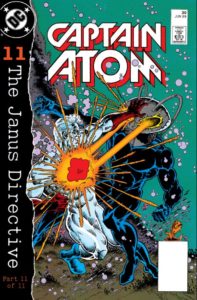
You’d be forgiven for thinking The Janus Directive ends with Suicide Squad #30. There were three epilogues that wrapped up the crossover succinctly, so the inclusion of Captain Atom #30 feels largely superfluous. Captain Atom also played a minor role, so I do not see why Squad readers would be interested in reading this. Black manta appears, but it feels tacked on just to give Captain Atom a bad guy to punch. And in any case, the cover art ends up being more entertaining than the actual “fight” that transpires.
The most interesting aspect of this issue is its commentary on race. Captain Atom’s daughter, Peggy, is engaged to his longtime friend, Jeff Goslin, who is black. Both Captain Atom and General Eiling make private remarks that are quite ignorant. However, Captain Atom checks himself and realizes his bigotry, understanding that the only reason he is questioning the engagement is because Jeff is black. And while I commend writers Greg Weisman and Cary Bates for having the courage to portray their protagonist so honestly, it still isn’t enough to warrant this issue’s inclusion in the overall crossover.
After going public in volume three, I was excited to see where this crossover would take the Squad. Unfortunately, The Janus Directive ends up being largely inconsequential. But we got our first look at Peacemaker, who looks primed for typical James Gunn shenanigans (Have you watched Super (2010) yet?) and witnessed some fun, no-holds-barred superhero action. But overall, this crossover was a bit draining, and I readily welcome a return to regular Squad activities. Thankfully, next issue is another personal files story. Based on previous entries of the same name, this next one should be good.
Suicide Squad
Credits
- Writers: John Ostrander, Kim Yale, Paul Kupperberg, Cary Bates, Greg Weisman
- Artists: Grant Miehm, Steve Erwin, Pablo Marcos, John K. Snyder III, Rick Hoberg, Doug Rice, Tom Mandrake, Rafael Kayanan
- Colorists: Carl Gafford, Julianna Ferriter, Pablo Marcos, Nansi Hoolahan, Gene D'Angelo
- Inkers: Karl Kesel, Al Vey, Romeo Tanghal
- Letterers: Todd Klein, Agustin Mas, Gaspar, Albert DeGuzman, Duncan Andrews, Carrie Spiegle
Credits (cont)
- Assistant Editor: Dan Raspler
- Editors: Robert Greenberger, Jonathan Peterson, Barbara Kesel, Dan Raspler, Denny O'Neil
- Publisher: DC Comics

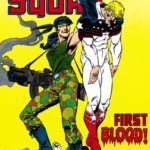

![[PODCAST] FANBOY POWER HOUR EPISODE 268: TINFOIL ABOUNDS](https://geekd-out.com/wp-content/uploads/2019/10/Fanboy-Banner-1-150x150.jpg)

One thought on “[RETROSPECTIVE] ‘SUICIDE SQUAD: THE JANUS DIRECTIVE’”